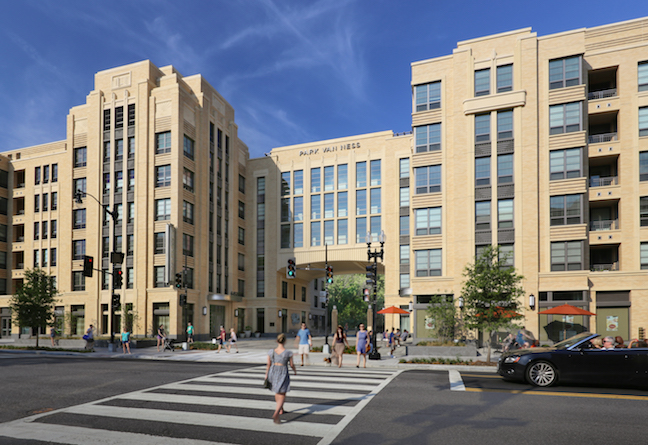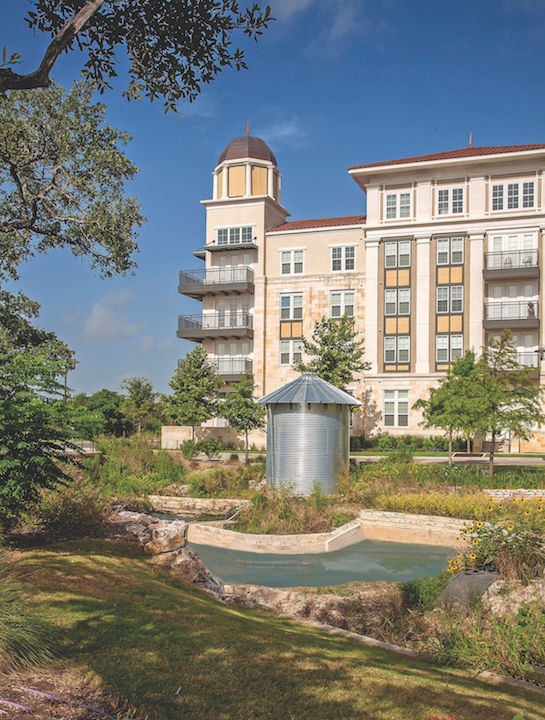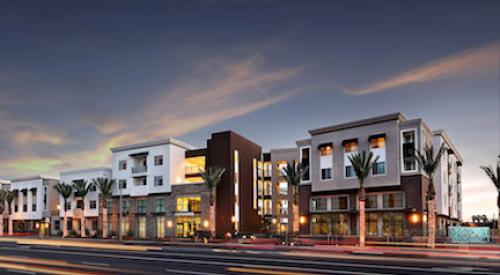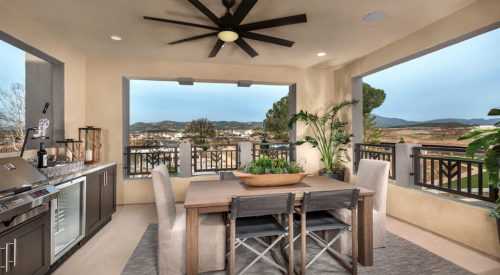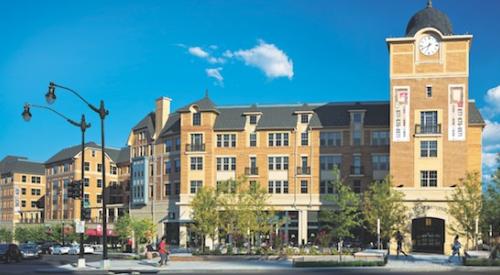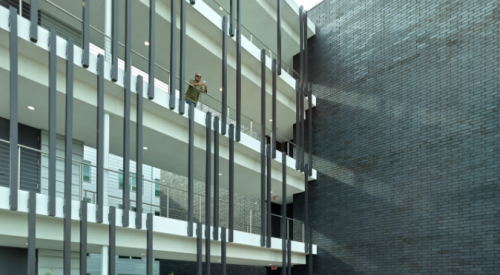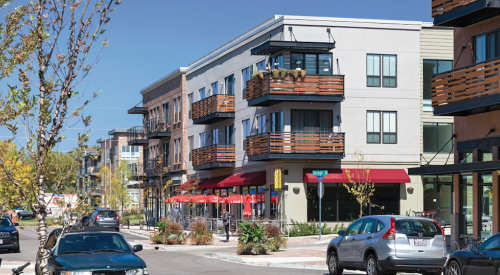Multifamily is rising, the shining center of the Venn diagram of empty nesters and Millennials. With so many interested parties now “renting by choice,” in the words of Daniel Gehman, studio director at Humphreys & Partners Architects, in Newport Beach, Calif., designers, developers, and builders are drawing in renters and condo owners. New multifamily housing is responding to consumer needs and desires in unprecedented ways, from high-end finishes and concierge services to coffee shops, pet spas, business centers, and rooftop barbecue areas.
Buyer Be Here
With everyone from Millennials, who are buying fewer cars, to Boomers, who are downsizing and don’t want to drive, the “walk-and-go” lifestyle—as Stephanie Williams, president of Greenbelt, Md.-based Bozzuto Management Company, calls it—is a driving force in multifamily location and design. It’s no surprise that people want to be able to shop as close as possible to where they live. “The supermarket has taken the place of the town center,” says John Torti, of Torti Gallas + Partners, based in the Washington, D.C., area. His firm has designed several suburban and city multifamily projects with grocery stores in them. Torti adds that the supermarket draws other businesses near it, such as restaurants and hardware stores. “You get a block and a half of intense retail that becomes the center of the neighborhood,” he says.
Many multifamily builders are finding success with first-floor live-work or flexible spaces zoned for commercial use. “People want quality mixed-use spaces,” says Victor Buchholz, principal at Looney Ricks Kiss architects and interior designers in Dallas. Some LRK projects are home to ground-floor real estate agents, architects’ offices, and art galleries. “It helps the long-term life of these projects to evolve and respond to the market. Cities desire activated ground floors.” He sees this happening in both suburban and city projects.
Community Connections
Multifamily housing is both a community unto itself and part of the larger community in which it dwells. Buchholz says a consumer desire for connection has changed the way LRK’s buildings are designed: “You have more connected ground floors, stoops that engage the street instead of being fenced off, and ground-floor units with the opportunity to walk out to the street.” In one of Bozzuto’s nine-story buildings in Baltimore, “There’s a coffee shop that spills into our lobby,” Williams says. “You can be in the neighborhood and sit in our lobby like [you would] in a hotel.” Previous design used to separate residents from the surrounding area, but now “residents like to invite people into the space, or nearby neighbors want to take ownership of the building and spend time in the lobby,” Williams says.
In cities, the surrounding neighborhood is an amenity. Important features include proximity to transit, restaurants, bars, and entertainment. “People want spaces in which they can live, walk, and shop. They want the convenience and the reward of living in a place that is a place,” Torti says. To provide community within the building itself, designers and developers offer gathering spaces such as rooftop decks, fitness centers, common areas, and doggy play spots and wash stations that help encourage interaction among residents. Two of those, in particular, are almost nonnegotiable. The gym is “indispensable,” Gehman says. Gym amenities are no longer small rooms with a few weights; many rival the commercial gym experience. In suburban multifamily projects, neighborhood amenities may include proximity to bike and walking paths.
The other top need is for pet amenities. Williams, whose firm manages 65,000 units along the East Coast and as far west as Chicago, says that “anywhere from 20 to 30 percent of residents in each building own pets, usually dogs.” Multifamily players are responding with pet-washing facilities and small parks or courtyards for dog walking. “We’re not doing any projects that don’t have a mud wash or dog spa,” Gehman says.
Built-in Bonuses
While renters have no say in interior finishes, the desire for ideal tenants in a competitive marketplace means that high-end flooring and countertops and stainless appliances are becoming standard. “Rich finishes are a demand throughout, whether entry level or discretionary,” says Everett Benke, project director at Robert Hidey Architects, in Irvine, Calif. Buildings required to have affordable units finish those units with the same products as the higher-end offerings.
Consumers also want high-speed Internet and even apartments with smart technology built in. But Williams would caution against doing too much in terms of technology. “We thought we were geniuses a few years ago when we created spaces to dock iPhones,” she says, “and then they changed the technology on us from iPhone 3 and 4 to 5. So now we do a little less in terms of infrastructure.”
Whether for environmental concerns or easy commuting, many apartment dwellers want bike parking and cycle repair areas in their buildings, and not just in bike-friendly cities such as Portland, Ore., or San Francisco. In Los Angeles, “you have to have massive bike storage facilities because of code,” Gehman says. “You have to provide one bike space per unit and a certain amount for guests and for commercial.”
Reduced Parking
Despite talk of walkability, parking plays a big role in multifamily development. Zoning codes require a certain number of spaces per apartment, and where to put cars informs building design. “Cars shape my building designs more seriously than neighborhood amenities,” Gehman says. Going forward, options for ride share and driverless cars will increase. Future use of current parking spaces must figure into the multifamily design equation.
Bozzuto Construction Company's president, Mike Schlegel, says that already in many of the developer’s projects, garages aren’t 100 percent occupied. “It’s not, ‘Will these autonomous vehicles become part of society someday?’ It’s, ‘When this happens, what will we do?’” Subterranean parking is limited to what can be done with it later on, such as conversion to storage or a health club. With an above-grade garage, “you’re going to make the ceiling height something a retailer might want,” Schlegel says. “You’ll need 12 feet, not 8, if you’re thinking about downstream.”
Recent statistics point to continued need for multifamily housing. To be competitive, stakeholders look to create spaces that are more than resting spots for those on the way to single-family homeownership. “The stigma has worn off, and renting is a lifestyle choice,” Williams says. “People get so much from the apartments built today; the services are so robust.”
![]()
Top-tier finishes, attractive gathering spaces and amenities, plus a sense of community characterize a new wave of multifamily buildings such as The Beacon, in New Orleans, designed by local firm Eskew+Dumez+Ripple. Photo: Timothy Hursley
![]()
To further engage with the surrounding neighborhood, the courtyard of The Beacon has seating and a roll-down projector for movie nights. Photo: Timothy Hursley
The Beacon at South Market District, New Orleans
New Orleans is growing, with an influx of transplants and locals moving there for jobs, says Hussein Alayyan, senior designer with Eskew+Dumez+Ripple. The Beacon, opened in 2016, is in a new five-block commercial district within the city’s central business district. The building, one block from the recently expanded Loyola streetcar line, is six stories with 126 units—lofts and one- and two-bedrooms units—above first-floor retail, with an in-house gym, a community space, bike storage, a private terrace, a clubroom, and a private meeting room. Car parking is located across the street at The Park, which the firm also designed and built. The courtyard design was inspired by the traditional New Orleans courtyard, and “the public is encouraged to come in and experience the space,” Alayyan says. To further engage with the surrounding neighborhood, the courtyard has seating and a roll-down projector for movie nights. The building also hosts concerts and shows in the courtyard.
The Park Van Ness in Washington, D.C., is a revitalization of a former mid-grade commercial building, with six stories in front and 11 in back. Photo: Brian Tomaino
Park Van Ness, Washington, D.C.
A luxury offering, the Park Van Ness project is a revitalization of a former mid-grade commercial building. The 600-foot-long building has six stories in front and 11 in back. Open-floor-plan units have one, two, or three bedrooms with high-end finishes that include wood flooring and Carrara marble bathrooms. Amenities include a rooftop pool, a clubroom, fitness center, 24-7 concierge services, and pet grooming. Architect John Torti, principal of Torti Gallas + Partners, believes the best amenities are the building’s in-house market and a high-end Italian restaurant. He says the city and neighborhood itself are what draw people to Park Van Ness, so he made sure the building was on a friendly scale that complements the surrounding neighborhood. “It’s a welcoming design and makes the neighborhood feel better about itself,” Torti says. “The urban building takes its cues from the city.”
The Residences at La Cantera in San Antonio, Texas, is part of a larger smart-growth plan. A larger retail center is located immediately adjacent to the project. Photo: Richard L. Muniz Photography
The Residences at La Cantera, San Antonio
Located 17 miles from downtown San Antonio, The Residences at La Cantera (about 300 units) is part of a larger smart-growth plan that architects Looney Ricks Kiss did for USAA Real Estate Co. called the Town Center at La Cantera. The one-, two-, and three-bedroom apartments are immediately adjacent to a large retail shopping destination, The Shops at La Cantera, on a main street that includes second-floor office space. “The hospitality industry has contributed a lot to the way we design multifamily communities in terms of amenities,” says LRK’s Victor Buchholz. Apartments have high-end finishes, stainless steel appliances, balconies for private outdoor space, courtyards designed to take advantage of shading and passive cooling, a fitness center and use of a nearby spa, a cybercafé/business center, a pet-washing station, and, in the next phase there will be an off-leash dog park.
Thanks to high demand and little product in downtown Detroit, The Scott has been a great success, offering a long list of physical amenities. Photo: John D'Angelo Photography
The Scott at Brush Park, Detroit
Detroit is turning around, with Millennials and empty nesters populating the downtown, says Richard Broder, CEO of Broder & Sachse Real Estate, developers in Detroit and Birmingham, Mich., who notes that there’s “high demand and little product.” Broder’s firm plays at the high end of the market, offering rentals with “concierge-level services.” The Scott is a luxury complex with 199 units: studios and one-, two-, and three-bedroom apartments ranging in size from 450 to 1,380 square feet. “People want to be greeted by name at the door,” he says. “They want advice on how to get tickets to this or that or where the best restaurant is. And there’s a laundry list of physical amenities.” These include a four-season heated sky deck overlooking the city; a second-floor community lounge with a kitchen, fireplace, and pool table; a pet grooming area and dog park; bike storage and repair station; a private reading room; a 24-hour fitness center; and parking.
The Alton, Irvine, Calif.
This project, says architect Daniel Gehman, studio director of Humphreys & Partners Architects, in Newport Beach, Calif., is urban infill in a part of Irvine known as the Irvine business complex. “It’s gradually upzoning,” he says. Parking was an important design driver, and The Alton is “tightly packed in its space”—a five-story wrap (known as a “Texas doughnut”) with 344 units. The parking structure is put to good use, with a pool and separate outdoor space that offers impressive views. “We’re not doing a project right now that doesn’t have a roof amenity,” Gehman says. The rooftop has several pockets where residents can relax together, as well as a roof deck fitness center and a play area for children. Other perks include a courtyard, clubhouse, bike repair area, and pet amenities.
